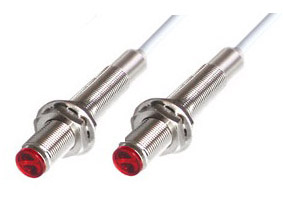SENSORS USED IN TEXTILE INDUSTRY
This article gives information related to different types of sensors used in spinning mills
Which improves quality of material , increases efficiency and also increases the production of mill.
THE DIFFERENT TYPES OF SENSORS:
-Capacity proximity sensor
-Inductive proximity sensor
-Magneto Restrictive sensor
-Photoelectric sensor
- CAPACITIVE PROXYMITY SENSOR :-
Capacitive proximity sensors produce an electrostatic field instead of an electromagnetic field and are actuated by both conductive and non conductive materials. A Capacitive sensor contains a high-frequency oscillator along with a sensing surface formed by two metal electrodes. When the target nears the sensing surface, it enters the electrostatic field of the electrodes and changes the capacitance of the oscillator. As a result, the oscillator circuit begins oscillating and changes the output state of the sensor when it reaches certain amplitude. As the target moves away from the sensor, the oscillator’s amplitude decreases, switching the sensor back to its original state Capacitive proximity sensors will sense metal objects as well as nonmetallic materials such as paper, glass, liquids, and cloth. They typically have a short sensing range of about 1 inch, regardless of the type of material being sensed. The larger the dielectric constant of a target, the easier it is for the capacitive sensor to detect. This makes possible the detection of materials inside nonmetallic containers.
The capacity proximity sensor is used to determine the mass variation of the material or the product. It is also used to determine the production parameters. This type of sensors are used in carding machine to check the feed lap weight , It is also used in draw frame to check the sliver weight per unit length . This sensor helps to increase the quality of the material .
- INDUCTIVE PROXYMITY SENSOR:
An inductive sensor is a device that uses the principle of electromagnetic induction to detect or measure objects. An inductor develops a magnetic field when a current flows through it; alternatively, a current will flow through a circuit containing an inductor when the magnetic field through it changes. This effect can be used to detect metallic objects that interact with a magnetic field. Non magnetic substance do not interact with magnetic field. So this sensor can be used in any condition.
The sensing range of an inductive switch is dependent on the type of metal being detected. Ferrous metals, such as iron and steel, allow for a longer sensing range, while nonferrous metals, such as aluminum and copper, may reduce the sensing range by up to 60 percent.
An inductive proximity sensor is mostly used in blow room line , it detect the metal parts present in the open cotton and removes it . In such way this sensor helps to reduce the damage of machine and product and do not cause any fire accident in blow room line.
- MAGNETO RESTRICTIVE SENSOR:
 |
| MAGNETO RESTRICTIVE SENSOR |
Sensors that monitor properties such as temperature, pressure, strain or flow provide an output signal that is directly related to the desired parameter. Magnetic sensors, on the other hand, differ from most of these detectors as they very often do not directly measure the physical property of interest. They detect changes, or disturbances in magnetic fields that have been created or modified by objects or events. The magnetic fields may therefore carry information on properties such as direction, presence, rotation, angle, or electrical currents that is converted into an electrical voltage by the magnetic sensor.
This type of sensors are used in the humidification plant for checking and maintaining the temperature and humidity of mill.
- PHOTO-ELECTRIC SENSOR :-
A photoelectric sensor, or photo eye, is an equipment used to discover the distance, absence, or presence of an object by using a light transmitter, often infrared, and a photoelectric receiver.
Both the light emitting and light receiving elements are contained in a single housing. The sensor receives the light reflected from the target.The transmitter and receiver are separated. When the target is between the transmitter and receiver, the light is interrupted.Both the light emitting and light receiving elements are contained in same housing. The light from the emitting element hits the reflector and returns to the light receiving element. When a target is present, the light is interrupted.
The photo electric sensor is used in the chutfeed system to sense the material requirement or card. It decreases the jamming of the carding machine, It also used in draw frame to check the presence or absence of the sliver or sliver break down , It is also used in speed frame to check the breakage of the material.








4 Comments
It's Good Information to all of Textile holders